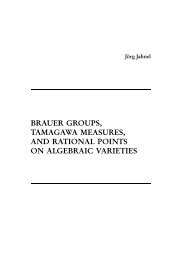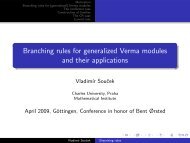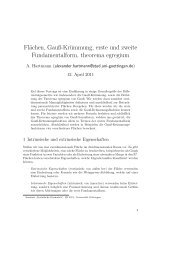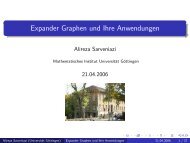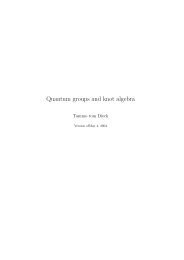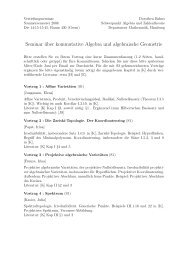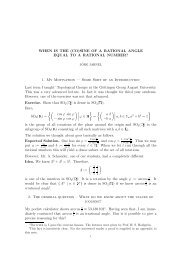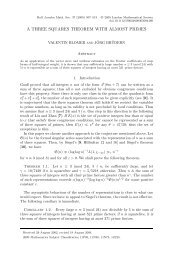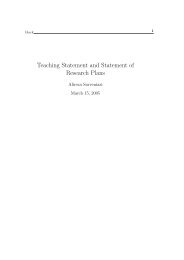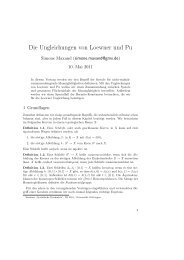Research statement (short version)
Research statement (short version)
Research statement (short version)
Create successful ePaper yourself
Turn your PDF publications into a flip-book with our unique Google optimized e-Paper software.
<strong>Research</strong> Statement<br />
I am a mathematical physicist currently working in gauge theories, string theory and algebraic<br />
topology, in particular K-theory. My interests in mathematics are very wide, focusing in the interface<br />
between topology, geometry and algebra, and in its relation with physics. I use and develop<br />
geometrical and topological methods to solve mathematical problems arising from string and gauge<br />
theories, and as a tool to give rigorous definitions to physical objects. In particular, my favourite<br />
fields of study include the geometry of fiber bundles, Dirac operators, and Index theorems, and<br />
the homological algebra of generalised homology and cohomology theories, with an emphasis on<br />
K-theory.<br />
Here follows a more detailed commentary on the projects I have been involved in.<br />
Gauge theories and differential cohomology. Gauge theories of p-forms play an important<br />
role in theoretical physics, as they appear as low-energy limit of string theories, e.g. the theory of<br />
Ramond-Ramond fields. In the same spirit as nonabelian gauge theories, they constitute a generalisation<br />
of Maxwell electromagnetism to the case in which the fieldstrenght is an higher differential<br />
form. Until recently, though, a rigorous mathematical description of these theories in topologically<br />
nontrivial backgrounds was lacking. In [5] the author proposes that these gauge theories are better<br />
described via generalised differential cohomology, an extension of ordinary cohomology through<br />
differential forms. In the same spirit, in [7] we study the gauge theory of Ramond-Ramond fields<br />
on global orbifolds of finite type. We introduce physical applications of the methods of Bredon<br />
cohomology [2], a powerful equivariant cohomology theory, showing that it perfectly captures the<br />
properties of the physical theory under study. Through an equivariant Chern character, we provide<br />
new Wess-Zumino couplings of topologically trivial Ramond-Ramond fields to D-branes which generalise<br />
previous ones to deal with arbitrary spacetime manifolds. We use this couplings to derive<br />
a quantization rule for the total fieldstrenght of the theory, and we show that this is given by<br />
the equivariant Chern character. In particular, one of the main mathematical achievement of this<br />
work consists in a generalisation of differential K-theory suitable for orbifolds. Ideed, this is a new<br />
mathematical result. We prove that this theory satisfies similar properties to the ordinary one, and<br />
we use it to investigate the flat fields contributions in specific cases of interest.<br />
D-branes and K-homology. D-branes consist of boundary conditions in the two-dimensional<br />
conformal field theory underlying string theory, and can (sometimes) be represented as submanifolds<br />
of the spacetime on which open strings can be attached. Moreover, they come equiped with a<br />
vector bundle and a connection describing a gauge theory on the brane itself. It is known that they<br />
carry some form of charge, and that they are dynamical objects, rather than static ones. One of the<br />
main advances in a mathematical understanding of D-branes on arbitrary spacetime manifolds has<br />
been the description of their charges via K-theory [8]. In particular, K-theoretical methods have<br />
shown to be fundamental in detecting possible anomalies, e.g Freed-Witten anomaly in a string<br />
theory with D-branes backgrounds [4]. An alternative mathematical description of D-branes is<br />
given by K-homology [1], the generalised homology theory dual to K-theory. This can be defined<br />
topologically, or geometrically, via triples (M, E, ϕ), where M is a spin c manifold, E is a vector<br />
bundle over M, and ϕ is an embedding map, or analytically, via Fredholm modules. In particular,<br />
the topological K-homology encodes geometrical information on the possible D-branes wrapping a<br />
submanifold of the spacetime, and takes into account various dynamical effects. In [6] we apply<br />
KO-homology, dual to KO-theory, to study branes in a type I superstring theory. More specifically,
we develop a geometric description of KO-homology, and an analytic one, based on the KK-theory<br />
of real C ∗ - algebras. One of the main mathematical achievement of this work is an explicit construction<br />
of an isomorphism between the two descriptions, based on the Cl(n)-index theorem for<br />
real vector bundles. Via topological invariants, we construct a homological Chern character, and<br />
describe torsion effects in D-brane charges. Moreover, we elucidate the importance of the grading<br />
in the KO-homology groups, and give a better interpretation of its cycles in terms of wrapping<br />
D-branes. Finally, for the first time we apply K-homology to the study of Ramond-Ramond fluxes.<br />
The hydrogen atom and reduction. This is a project I was involved in soon after graduating,<br />
and before beginning my PH.D. studies.<br />
Reduction procedures have been widely used as a powerful tool in the study of classical systems,<br />
and symplectic manifolds with symmetries. It is known, in particular, that different classes of<br />
completely integrable systems can be obtained as reductions of free, or simpler systems in higher<br />
dimensions, allowing for a complete solution of the system’s dynamics. Although reduction procedures<br />
have had a lot of consideration in the classical setting, the same has not happened in the<br />
quantum setting, at least not in a systematic way. For this reason, through the study of the well<br />
know hydrogen atom, in [3] we try to make steps forward the development of a quantum reduction<br />
procedure. Our main point is based on the algebraic description of the classical reduction procedure,<br />
which translates as an homomorphism of Lie algebras of vector fields, associated to suitable<br />
maps between the configuration spaces. In the same spirit, we propose a quantum reduction procedure<br />
based on homomorphisms of algebras of differential operators on manifolds. In particular, we<br />
introduce a general notion of reduction for differential operators on an arbitrary manifold, which<br />
can be used in various physical context, as not necessarily linked to quantum mechanics. Then we<br />
apply this technique to show that the hydrogen atom in four dimension can be obtained as a quantum<br />
reduction of a family of harmonic oscillators, allowing an easy computation of its spectrum,<br />
and a straightforward analysis of its algebra of symmetries.<br />
Future <strong>Research</strong><br />
In my future reasearch I would continue to investigate the mathematical aspects of gauge and string<br />
theories in non trivial geometrical and topological settings. An interesting case is given by the homological<br />
analysis of D-branes when a B-field is present, where twisted K-homology is the right<br />
framework to be in. In particular, twisted K-homology comes in different geometric realisations,<br />
but it’s not clear which one encodes the correct description of D-branes. Indeed, investigating the<br />
mathematical relation among them can shed light on new physical phenomenons not yet seen in<br />
the current formalism.<br />
Another aspect I would concentrate on is the further development of the mathematical methods<br />
used in [7], in order to have a better understanding of the global properties of Ramond-Ramond<br />
fields on orbifolds, in particular their dynamics, and of nonperturbative aspects of orbifolded string<br />
theory, e.g. the presence of possible orbifold anomalies when D-branes are considered.<br />
As my interests span various fields of mathematics and physics, I will also be very willing to increase<br />
my knowledge of mathematical methods not only in the area of geometry, topology and algebra,<br />
but in the mathematics of (quantum) field theory in general.<br />
References<br />
[1] P. Baum and R.G. Douglas. K-homology and index theory. Proc. Symp. Pure Math. 38, 117–<br />
173 (1982)
[2] G. Bredon. Equivariant cohomology theories. Springer Lecture Notes in Math. 34 (1967)<br />
[3] A. D’Avanzo, G. Marmo, A. Valentino Reduction and Unfolding for Quantum Systems: the<br />
Hydrogen Atom, Int.J.Geom.Meth.Mod.Phys. 2 (2005) 1043-1062<br />
[4] D.S. Freed and E. Witten. Anomalies in string theory with D-branes. Asian J. Math. 3, 819–851<br />
(1999) (arXiv:hep-th/9907189)<br />
[5] D.S. Freed. Dirac charge quantization and generalized differential cohomology. Surv. Diff.<br />
Geom. VII, 129–194 (2000) (arXiv:hep-th/0011220).<br />
[6] R.M.G. Reis, R.J. Szabo and A. Valentino. KO-homology and Type I string theory. Preprint<br />
arXiv:hep-th/0610177 (2006), submitted to Comm. Math. Phys.<br />
[7] R. J. Szabo and A. Valentino, Ramond-Ramond Fields, Fractional Branes and Orbifold Differential<br />
K-Theory. Preprint (arXiv:0710.2773)[hep-th], submitted to Comm. Math. Phys.<br />
[8] E. Witten. D-branes and K-theory. J. High Energy Phys. 9812, 019 (1998) (arXiv:hepth/9810188)



